BEFORE | In Need of Saving
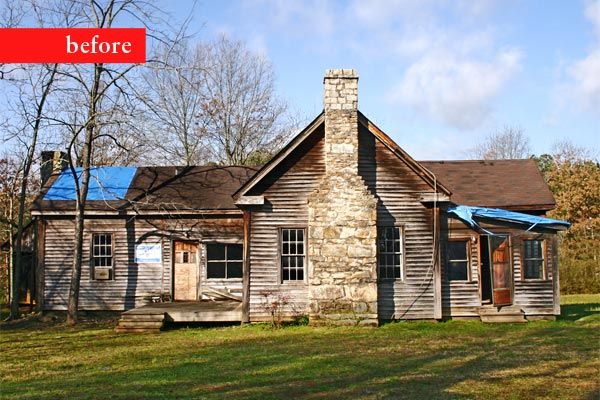
Who: Scott Pluckhahn and Keith Crosby
Where: Lithonia, Georgia
Issue: May 2012
“When I look back, we were really crazy to do this,” jokes Scott Pluckhahn, fondly recalling the day he and partner Keith Crosby committed to buying and restoring the 1,200-square-foot Housworth farmhouse, just outside of Atlanta. The Georgia natives had been living in a cottage nearby when they first toured the historic home, which was for sale two years before it appeared in the magazine’s Save This Old House column. “We were looking for something with an interesting history,” says Scott. “We just loved that it had only been owned by one family. It looked like it was frozen in time, it was so rustic!”
Shown: In a nod to the house’s origins as a farmer’s cottage, the homeowners grow cotton and tobacco in the parterre garden.
AFTER | Storied Farmstead
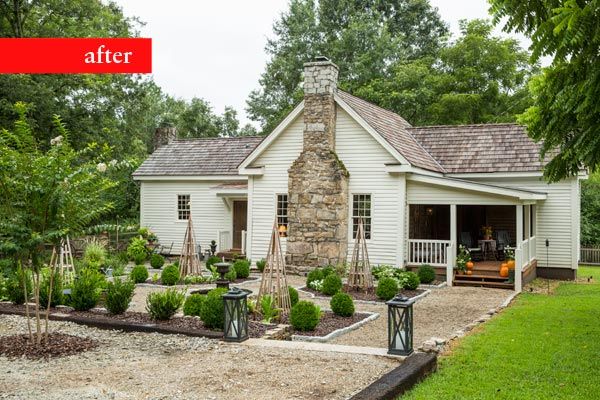
“Rustic” was a generous description of the place: The leaking roof, rotted siding, and collapsing porches might have sent many a buyer scurrying. But Scott and Keith saw past those problems to the original 1840s details, such as the intact pine paneling and the granite fireplace, and they loved the picturesque setting, which included a seven-acre parcel.
Fast Real Estate Action
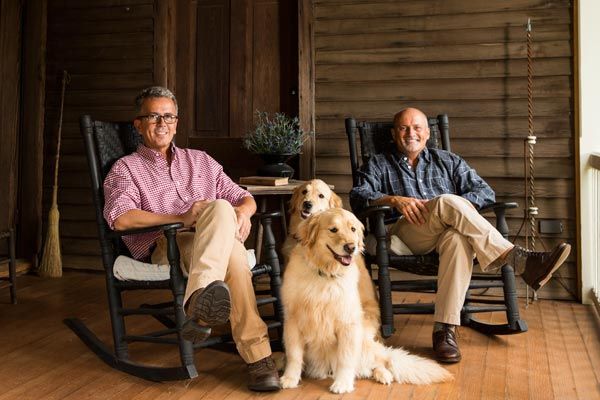
Built by the Housworth family, who farmed the plot and drew their water from a nearby creek (indoor plumbing didn’t arrive until the 1980s), the house had barely escaped General Sherman’s March to the Sea, which left much of the area ravaged. Learning it was slated to appear in the pages of This Old House really kicked the couple’s decision-making into high gear. “We knew it wouldn’t be long before another reader swept in and bought the place,” recalls Scott.
Shown: Homeowners Scott Pluckhahn and Keith Crosby
Pine-Rich Living Room
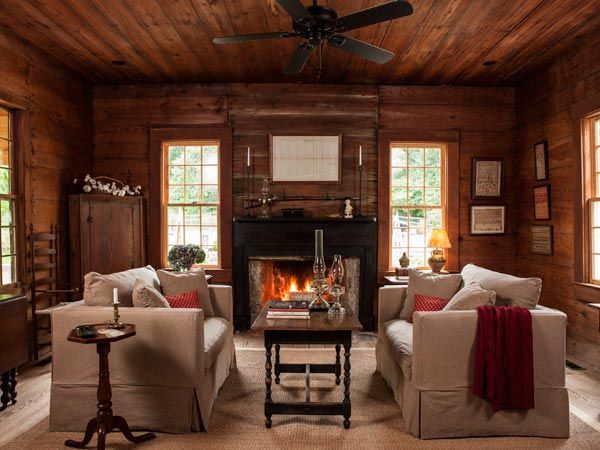
Soon after, with the purchase complete, they got to work. “Lots of people would have covered up the dark paneling inside,” says Keith. “But we have a deep appreciation for early American history, so we did everything to preserve the original integrity of the house.” The couple opted to have a period-appropriate cedar-shake roof installed and replaced about half of the lap siding before painting the exterior. The front porch, enclosed during a 1980s renovation, was opened up and restored. Determined to preserve the southern-yellow-pine walls and ceilings, which miraculously had never been painted, Scott and Keith set about hand-scrubbing the boards themselves and left them in their original state. “There were certainly hiccups along the way,” says Scott, “like the downpour that came when a portion of the roof was still missing! Thankfully, Keith was home and managed to jury-rig a tarp and a section of pipe to route the water out through a nearby window.”
Shown: Original pine boards plank the walls, floor, and ceiling in the living room. The space also retains what is believed to be the original wood mantel, which was likely stained black to conceal soot.
Combo Dining Room and Kitchen
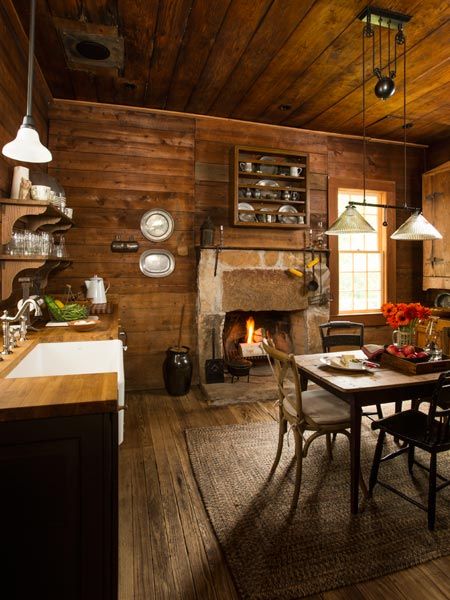
As a blueprint for much of the renovation, the couple relied on a similar house from the period, which had been restored by the Atlanta History Center, not far from their house. The restoration now complete, the couple has since opened their home to the public, conducting tours of the house and surrounding land. “We see it as a chance to educate people on life in the South before the Civil War,” says Keith. On one recent occasion, Housworth descendants stopped by after a family reunion to tour the home many of them remembered from childhood. “To know that the great-grandson of your home’s first owners is standing in your living room, admiring the work you’ve done, is pretty incredible,” says Scott. “It doesn’t get much better than that.”
Shown: A granite fireplace partially heats the combination kitchen and dining room. The stones were quarried over 160 years ago from nearby Arabia Mountain.
Claw-Foot Tub
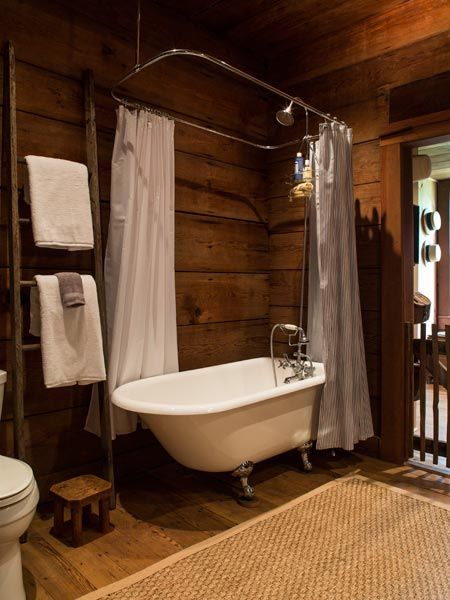
A claw-foot tub, ceiling-hung shower-curtain ring, and ladder-style towel rack helped keep the original pine paneling intact.
Charming Bathroom
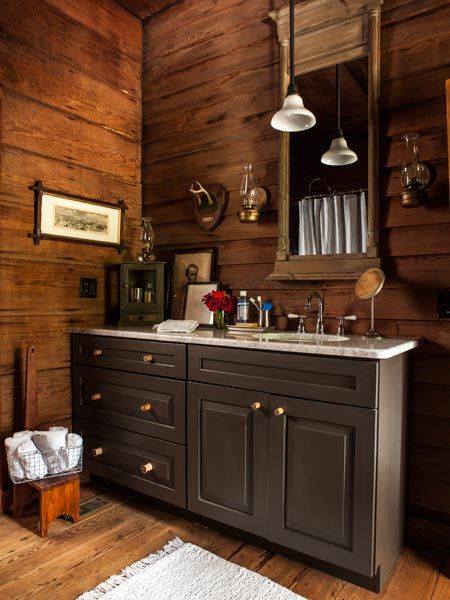
The bathroom features a freestanding vanity and a claw-foot tub, to prevent damaging the wall paneling.
Thread Spool Drawer Pulls

The original owners would have had thread spools in abundance and might have used them in lieu of fancier hardware.
Homegrown Cotton
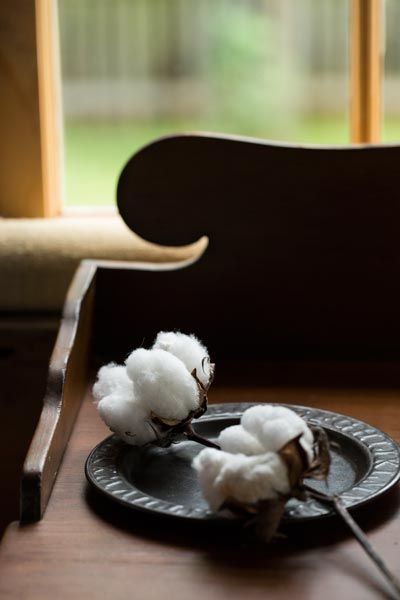
Cotton bolls from the garden hark back to the farmstead’s early days.
Replica Nine-Over-Nine Windows
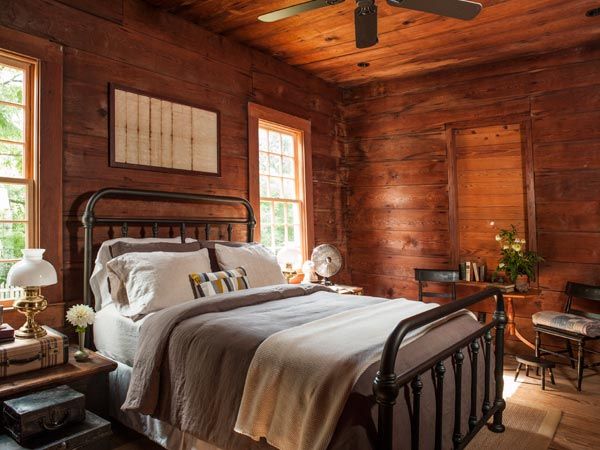
The master bedroom’s nine-over-nine windows are replications of an intact original Scott and Keith found during the renovation.
Restored Porch
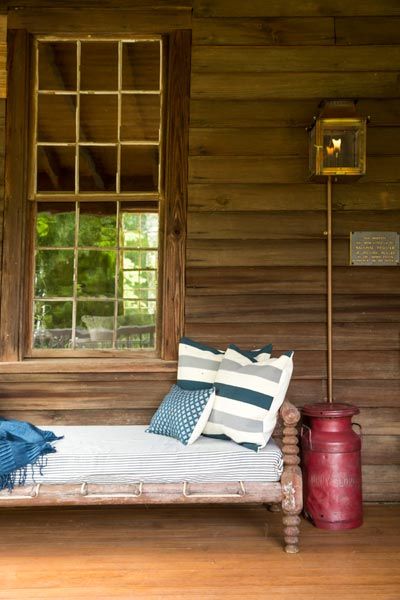
Now a favorite lounging spot, the large porch was opened up and restored during the renovation.
Porch Stair Construction
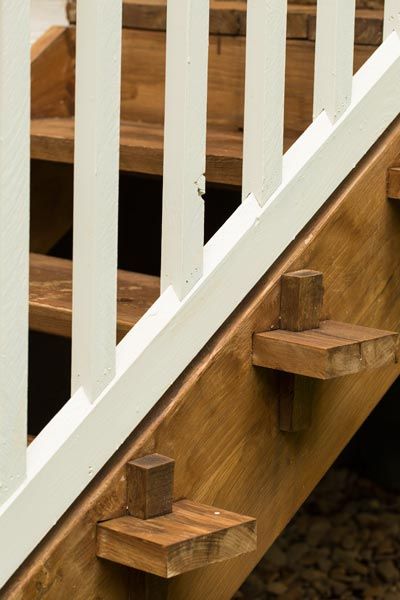
The porch stairs were rebuilt with treads fastened using mortise-and-peg joinery, a design that would have spared the use of nails, which were once a pricey commodity.
Period-Perfect Garden Shed
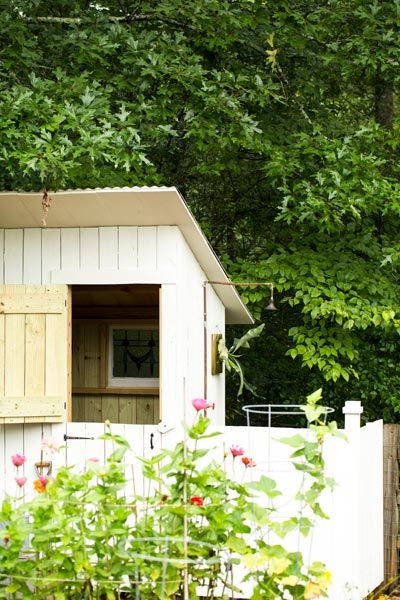
This small garden storage shed is new. To draw inspiration for its design, the homeowners turned to surviving outhouses from the era to ensure the structure would blend in.
Formal Parterre

Scott, a landscape architect, designed the formal parterre that graces the front of the house. “While appropriate for the period, this style of garden would have been found at a fancier house than this one,” he says.
See the house’s original column: Save This Old House: A Historic Georgia Farmhouse
BEFORE

Who: Damon and Cindy Beyer
Where: Deer Isle, Maine
Issue: January/February 2001
“When I saw the house, I knew it could be my one shot at having the vacation house of my dreams,” says Damon Beyer, a seemingly unlikely candidate for buying and moving a massive 5,600-square-foot Stick Style house in Maine. A resident of Texas, Damon first got a glimpse of the place on the back page of TOHduring a layover at the Phoenix airport while traveling on business. He frantically called his wife, Cindy, who encouraged him to see the house for himself.
Shown: The handsome Stick Style house was cut into panels and trucked more than 170 miles, from Biddeford, Maine, to Deer Isle, before being rebuilt on a new lot.
AFTER
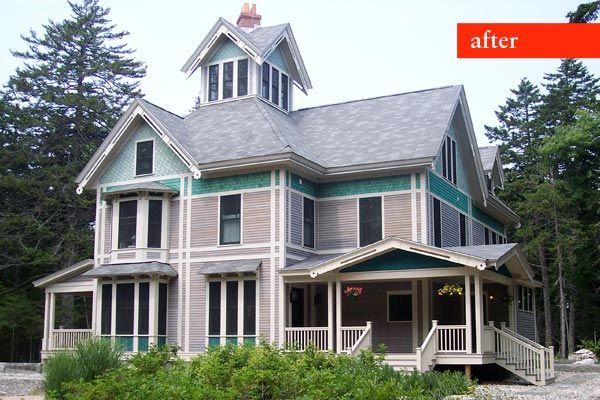
Some quick rejiggering of his return flight allowed for a stopover in Maine, where he’d arranged to tour the house and meet with an architect and house mover. “It was a total mess, but I just loved it anyway,” he says. “The stick work was completely intact, and the casings around the bay windows were simply stunning.” A short time later, the couple signed the papers, paying just $1 for the deed, and embarked on the lengthy odyssey of disassembling, moving, and rebuilding the place on Deer Isle, the only coastal area nearby with zoning laws that would permit the home to be rebuilt to its original height of 36 feet. The lot they purchased came with a small farmhouse, which Damon restored so that he, Cindy, and their two children had a place to stay while the main house was rebuilt.
New Homeowners

Four years later, the family was able to move in. What was supposed to be just a summer house has become a favorite getaway—the family has spent Christmas there for the past five years. “It was a huge struggle to pull this off,” Damon admits, “but I’m so glad we did. In our entire lives, we never could have found anything else quite like it.”
Shown: Damon and Cindy Beyer, Deer Isle, Maine
Window Seat Nooks

Restored window bays were fitted with bench seating to create reading nooks throughout the house.
Replica of 1920s Addition

The large kitchen occupies a replica of the 1920s addition that was left in Biddeford but reproduced after the house was moved.
BEFORE
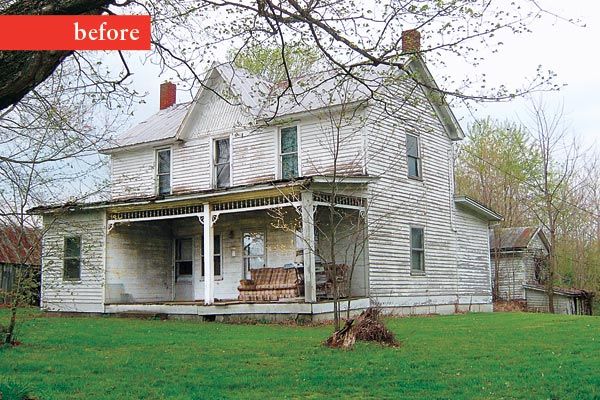
Who: Ann and Kevin Mutschler
Where: Pekin, Indiana
Issue: October 2010
“If we didn’t buy this house, I knew we’d regret it for the rest of our lives,” says Ann Mutschler, who, with her husband, Kevin, decided to ditch their fast-paced lives in San Jose, California, buy their dream home, and move across the country with their two children. “Kevin and I had always wanted to restore an old farmhouse together,” says Ann. “It just happened to be in Indiana.” Ann had never even visited the Hoosier State, let alone considered living there. But after reading about the quaint Gothic Revival online, Kevin flew out to see it for himself. Standing in front of the house for the first time, he called Ann and said simply: “It feels like home.” He shot a quick video before returning to show the family. “I remember tearing up when we watched Kevin’s video,” says Ann. “I saw the sweet porch with gingerbread trim, and the grassy fields all around, and I knew immediately it was the life I wanted for my kids.”
Shown: The circa-1850s farmhouse got a new coat of paint and a white picket fence.
AFTER
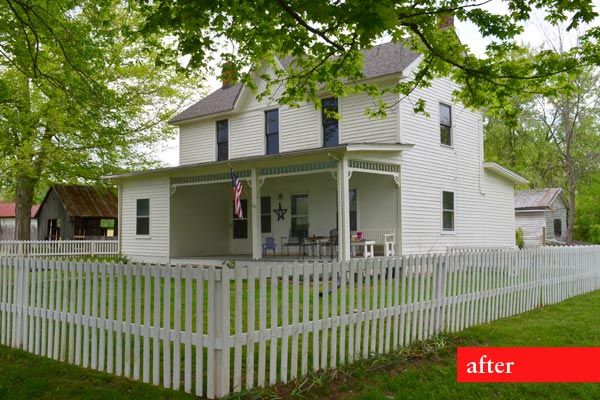
Six weeks later it was theirs, and the family flew across the country to take up residence in an apartment around the corner from their new home. It took Kevin nearly nine months of hard work before the family could move in; a few unexpected discoveries, including rotted joists and structural beams, pushed the timeline back.
Proud Homeowners

There’s still work to be done, like replacing floors in the living room and tackling the second-floor bedrooms, but the family is steadfast in its commitment to the place. “I knew plenty of people would tell us we were crazy for doing this,” says Ann, “but I’m amazed how many have confessed that they’ve often dreamed of doing the same thing. And we get to live that dream every single day.”
Shown: Ann and Kevin Mutschler of Pekin, Indiana
Pasture View
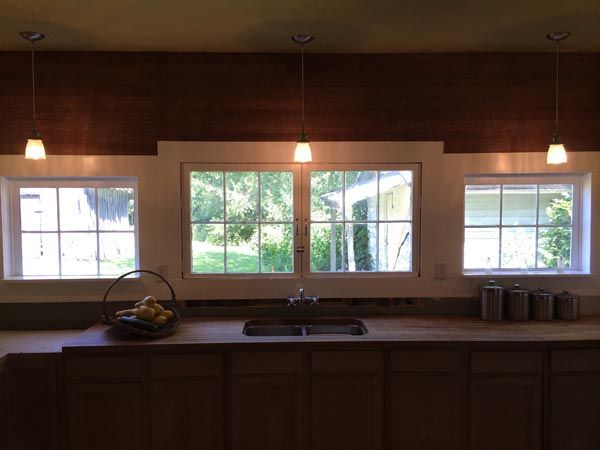
The kitchen looks out onto pastureland that the family uses for vegetable gardens and raising chickens.
Salvaged Pedestal Sink
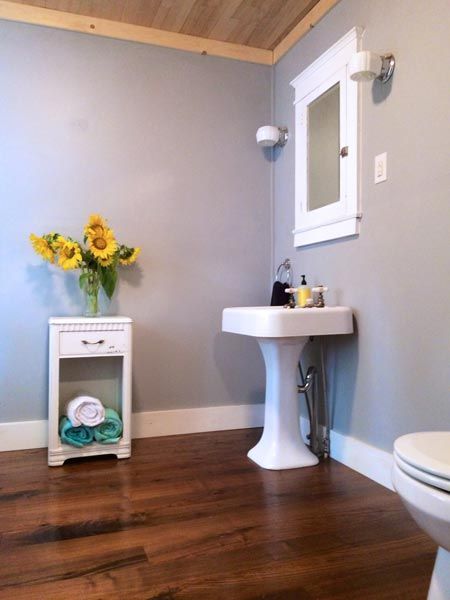
From the beginning, Ann and Kevin were determined to do as much of the work themselves as they could—Kevin built in the medicine cabinet in the bathroom, and they salvaged the pedestal sink.